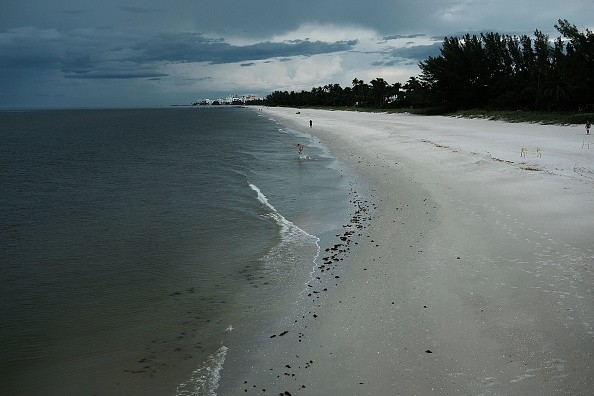The red tides have been wreaking havoc on the Florida coast for several months, but this week has been particularly bad, with the Florida Fish and Wildlife Conservation Commission reporting that 89 of 157 samples from the waters off Florida's Gulf Coast tested positive for the algal bloom.
Red Tides Sparked by Human Activity and Climate Change
 (Photo : Spencer Platt/Getty Images)
(Photo : Spencer Platt/Getty Images)

According to the Tampa Bay Times, this has resulted in around 20 tons of dead fish and debris washing up on Florida beaches since December 12, as well as dead turtles and manatees being discovered, and the BeachFest festival, which is held annually in Indian Rocks Beach, Florida, being canceled a month in advance.
Red tides, so-called because of the rust-red color they frequently cause in coastal waters, are algae blooms, also known as harmful algal blooms, as per Newsweek.
According to Larry Brand, a professor of marine biology and ecology at the University of Miami's Rosenstiel School of Marine and Atmospheric Science, the Florida red tide is a harmful algal bloom caused by the algae Karenia brevis.
It occurs naturally in low concentrations in the Gulf of Mexico, but can occasionally form dense blooms. These blooms are most common along the coast from Tampa Bay to Naples.
Karenia brevis produces brevetoxin, a neurotoxin that is released into the water and air when the algal cells are disturbed and broken open.
These toxins primarily affect vertebrate neurons and can kill fish, dolphins, manatees, sea turtles, and sea birds at high concentrations.
According to the Tampa Bay Times, a 10-foot manatee was discovered dead and floating in Boca Ciega Bay on March 1. This is the seventh manatee to die as a result of the red tide this year.
Red tides can also harm humans who are exposed to the toxins, either by breathing in the toxic fumes or eating fish and shellfish that have consumed the algae.
Those who inhale the toxins may develop symptoms such as coughing, eye irritation, or worsening asthma.
Red tide blooms can also have an indirect impact on other species by depleting dissolved oxygen in the water or blocking light from reaching photosynthesizing plants on the seafloor.
It is unknown why these blooms occur, and predicting when and where they will occur is difficult. However, nutrient levels in the water are thought to be a major factor in their occurrence.
Blooms are caused by a complex chain of events that begin with conditions that favor their growth more than 80 miles offshore in the Gulf, currents that move them closer to shore, and pollution that intensifies and prolongs the blooms, according to Don Boesch, a marine science professor at the University of Maryland Center for Environmental Science.
Also Read: Red Tide Threatens Gulf of Mexico Fish
Climate Adaptation and Harmful Algal Blooms
Algal blooms from red tides, blue-green algae, or cyanobacteria can have serious consequences for water quality, human health, aquatic ecosystems, and the economy, as per EPA.
Climate change will cause higher air temperatures, which may result in higher water temperatures.
Higher water temperatures, combined with increased nutrient runoff from stormwater, can create conditions favorable for algal blooms.
As a result of climate change, harmful algal blooms may occur more frequently, in more fresh or saltwater bodies, and with greater intensity.
An increase in harmful algal blooms (HABs) can degrade source water quality and increase the need for drinking water treatment.
Harmful algal blooms may endanger public health by lowering the quality of source water or by affecting people with respiratory conditions.
Toxins produced by harmful algal blooms can kill fish and other animals.
Even if algal blooms are not toxic, they can negatively impact aquatic life by blocking sunlight and clogging fish gills.
Algal blooms can also cause "dead zones," which are areas of water with little or no oxygen where aquatic life cannot survive.
As a result, an increase in the occurrence of harmful algal blooms can have a negative impact on the effectiveness of ecosystem protection efforts.
Related article: Red Tide on Sarasota County Scatters Dead Fish on Beach, Shark Teeth Hunters Clean Up Instead - Florida
© 2024 NatureWorldNews.com All rights reserved. Do not reproduce without permission.

![Tsunami Hazard Zones: New US Map Shows Places at Risk of Flooding and Tsunamis Amid Rising Sea Levels [NOAA]](https://1471793142.rsc.cdn77.org/data/thumbs/full/70325/280/157/50/40/tsunami-hazard-zones-new-us-map-shows-places-at-risk-of-flooding-and-tsunamis-amid-rising-sea-levels-noaa.jpg)



